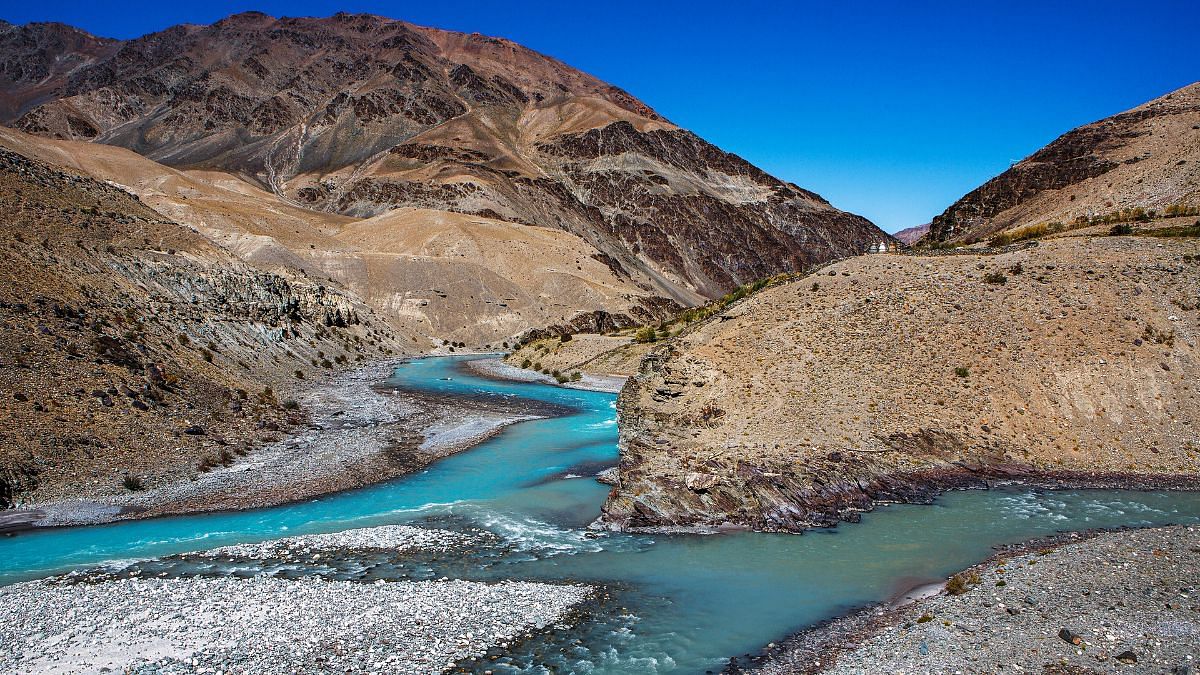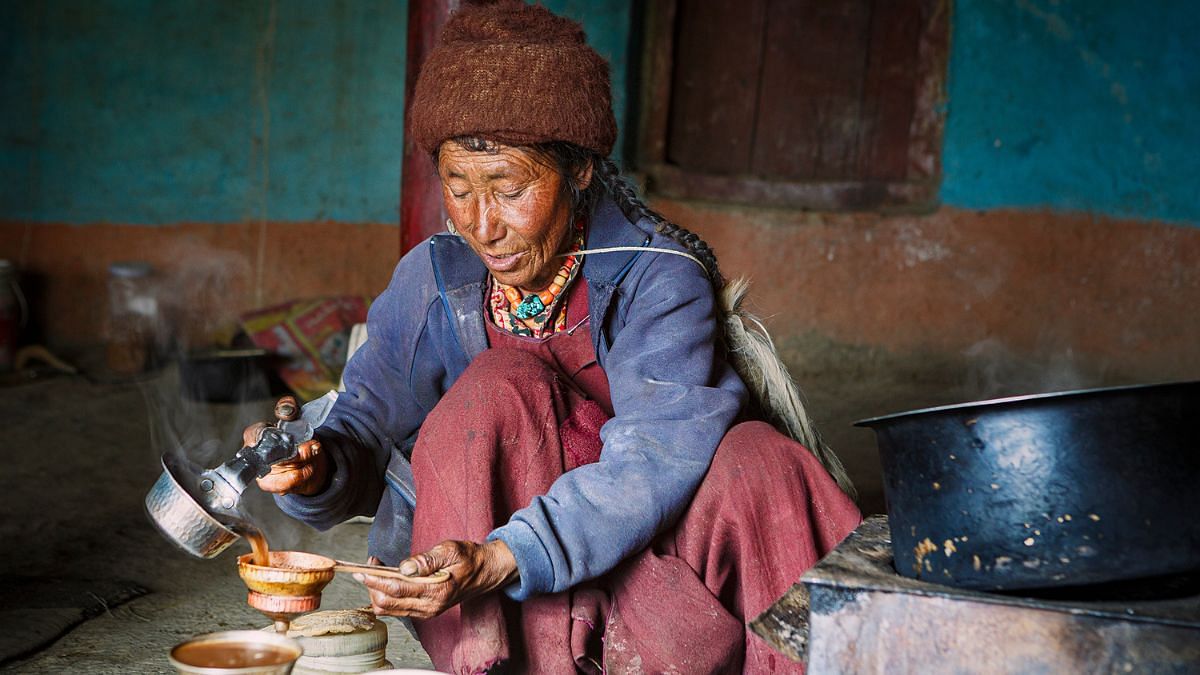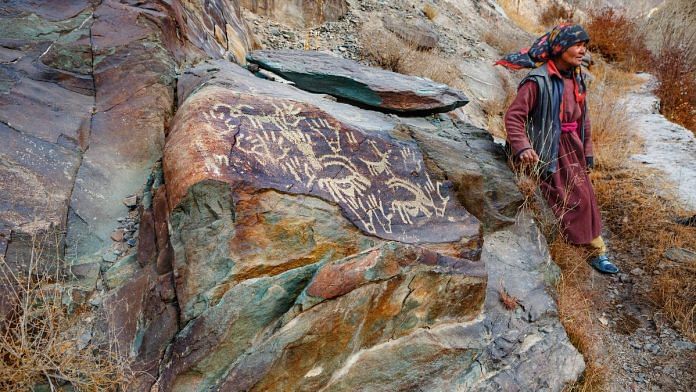The Zanskar region in southwest Ladakh, straddles the area between the two main branches of the Zanskar River: the Tsarap and the Stod. While part of Ladakh’s vast Kargil district, its distinct culture, topography and relative isolation create an invisible boundary that designates it as a separate entity.
Zanskar is not just the name of the region, but also of the vast rocky range and the river that flows through it. Unlike with other rivers in Ladakh, the Zanskar travels through a tough canyon for a large portion of its length, with no river banks to allow trespass into or out of the region. This gorge is only accessible in the summer through inflatable rafts, or in the winter via a walk down its icy chadar (sheet). Today, additional road routes are fast encroaching on its remoteness, but this hidden Shangri-La remains as enticing as it was when Ladakh first opened up in 1974. The same cannot be said for the petroglyph sites in this region, as most of the sites detailed here have been destroyed. In 2015, the Nimu-Chilling sites were cleared for road development, while its rocks were likely picked for construction in mainland Zanskar.
The Land of White Copper
Zanskar is an otherworldly place, cut off from the rest of the world for six months of the year, especially when its high pass routes are snowed in during the long, harsh winters. The lively torrent that bears its name has its source on the northern side of the Great Himalayan Range. When the Indian and Eurasian plates collided 50 million years ago to create the Great Himalayan range, a piece of the prehistoric Tethys ocean floor slid beneath Tibet, to create the Zanskar Range. Its arid terrain features untamed rock formations, with deep rivers dividing it along its geological fault lines.
The journey from Leh to Zanskar takes two days, across a lunar landscape peppered with monasteries carved into the layered rock. The hanging glaciers and steep peaks of the Great Himalayan Range, which frame the final road drive into the area, more than compensate for the region’s weakest road access. Padum, the historical capital of ‘Zangskar,’ the ‘land of white copper’ (zang is the local word for the metal, possibly mined here), is the major centre from which to venture into the adjacent valleys. The Zanskar River has carved a course through the range, creating a hemmed-in cathedral of near-vertical rock sides, rising a few thousand feet out of the riverbed, and aptly referred to as ‘the Grand Canyon of the East’.
Downriver, at rocky outcrops, along its bank, petrified ammonite coiled shells are a sobering reminder that these mountains erupted from the ocean floor millions of years ago. The scenes and panels on the left bank of the Zanskar River (eight in all) over the almost thirty-kilometre riverine length between Nimu and Chilling were similar to styles prevalent in Western Tibet and Central Asia. An intriguing snow leopard family stood atop the smooth, eroded shelf of a freestanding rock. Unfortunately, the majority of the landmarks along this path were destroyed by a road expansion project in 2015, a fate that has befallen many rock art sites throughout Ladakh.

Also read: How unique ‘Bazaar paintings’ fuelled trade in colonial India
A Mythical Bird
Tibet’s native Bön religion predated the arrival of Buddhism in Tibet during the Iron Age. Some Bön practices were eventually incorporated into Tibetan Buddhism. Khyungs, or mythological horned eagles, were the primary political emblem and genealogical symbol of Zhang Zhung, an ancient dynasty and culture based in Upper Tibet. The highest concentration of khyung images (ten in all), have been recorded in the Zanskar gorge alone, near Yaru and Yaru Bridge. The bird represents a mountain and clan protector spirit, as well as a tutelary god for lamas and spirit mediums. Khyung rock images have significant symbolic value, emphasising Ladakh’s cultural links with western Tibet.
Interestingly, the presence of horns and the portrayal of the tail in the shape of a triangle with the wings facing forward and downwards, distinguish the khyungs observed in Ladakh.
Also read: Langda, Kesar to Alphonso—how mangoes shaped art, politics & culture in India
In the footsteps of the ancients
Since ancient times, embarking on the voyage into Zanskar has been a difficult and time-honoured undertaking. Modern roads may now provide access, but tracing the pathways of old trade routes on foot offers rewarding experiences. The 120-kilometre Lamayuru-Padum trail crosses eight high mountain passes, a 12-day odyssey that offers a demanding journey that unveils some of Ladakh’s most scintillating landscapes. In 2013, I embarked on this dramatic trek, choosing a formidable yet deeply rewarding route into the region. Mountain settlements on towering granite walls, grace the route. Wind-eroded spires ascend from valleys through which glistening rivers and streams weave. Along this arduous trail, Ladakh’s warm and welcoming residents are gracious hosts, and homestays are a delightful opportunity to pause and rest along the way.

Mainland Zanskar, today, is bereft of any special petroglyph locations. Even the few unique rocks documented by Rob Linthorpe in the 90s are now virtually impossible to locate. However, two of Zanskar’s significant Buddhist-era sites, Gorghor (near Padum) and Sani Gompa, remain well-guarded and are certainly worth a visit. Sorties around the valley reveal petroglyph-bearing rocks in a sad state of disrepair. Martin Vernier had meticulously documented 825 engravings from Zamthang (a three-day trek into the Lugnak valley) in 1999 and 2004, making it the largest site in Zanskar and one of the top ten sites in Ladakh. Thematic discoveries placed the site to be from the Bronze and Iron ages (between 2500 and 300 BCE). Sadly, it has been demolished to make way for a new local educational facility. All that remains are a few etchings.
The renowned Phugtal cave monastery can be reached after a three-hour trek into the Tsarap valley. Constructed into a cliffside and encircled by a vast natural cave, its location above the gorge adds to the enchantment of the Tsarap canyon with its copper-red walls. In use for more than 2,000 years, it is believed that the 16 Arahats, the mythological followers of the Buddha, were among its early residents.

Nestled above the Cha village lies another remarkable petroglyph site, distinguishing itself from the typical cliff and boulder settings with engravings that grace relatively flat slabs of rocks, almost at ground level. While the rocks bear traces of fading and rigorous re-patination, the fully pecked ibex and bow hunters still command attention with their stunning detail. A significant portion of these ancient etchings is obscured by later artwork, a testament to this site having been occupied across generations.
The road route that snakes in from Darcha over the Shingo La into the valley has now unlocked access to this otherworldly place, which still remains a draw only for the truly adventurous. With the onset of winter, the valley and Zanskar gracefully retreat into slumber. As road access shuts down, the land returns to its peaceful solitude.
 This excerpt from Speaking Stones: Rock Art of Ladakh by Ahtushi Deshpande has been published with permission from the author.
This excerpt from Speaking Stones: Rock Art of Ladakh by Ahtushi Deshpande has been published with permission from the author.






